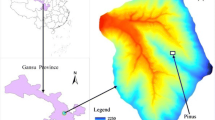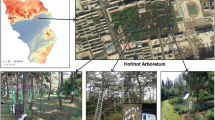Abstract
Farmland shelterbelt is an important biome for protecting the oasis agricultural system, and Populus simonii Carr is the main tree species of farmland shelterbelt. The unknown mechanism of controlling tree transpiration under different drought conditions restricted the development of farmland shelterbelt. In this study, we applied sap flow to measure stand transpiration, coupled with calculating canopy conductance, aerodynamic conductance and the decoupling coefficient, to identify the effect of environmental change on farmland shelterbelt transpiration and protection. Results showed stand transpiration of the farmland shelterbelt increased with soil water content rising, the stand transpiration was 7.69 L d−1, 10.48 L d−1 and 15.96 L d−1 at heavy drought, medium drought and wet period, respectively; the daily canopy conductance ranged from 5.32 × 10−5 to 5.24 × 10−4 ms−1. Climate change and water stress affected farmland shelterbelt transpiration by changing stomata and leaf area index. Stomata controls most of the stand transpiration in heavy dry and wet periods, while temperature, relative humid and solar radiation play more important roles in moderately dry periods. In the shelterbelt, it is the atmospheric demand and vapor pressure deficit that control farmland shelterbelt stand transpiration. This investigation provides a preliminary interpretation of the mechanism of the motion of shelterbelt transpiration in China’s semi-arid region.








Similar content being viewed by others
Change history
31 May 2020
In the original publication of the article the author Prof. Yi Luo was not included as co-corresponding author and the corresponding affiliation was missed. This has been corrected with this Correction.
References
Anderegg WR et al (2015) Tree mortality predicted from drought-induced vascular damage. Nat Geosci 5:367
Bai J, Chen X, Li L, Luo G, Yu Q (2014) Quantifying the contributions of agricultural oasis expansion, management practices and climate change to net primary production and evapotranspiration in croplands in arid northwest China. J Arid Environ 100:31–41
Bush SE et al (2008) Wood anatomy constrains stomatal responses to atmospheric vapor pressure deficit in irrigated, urban trees. Oecologia 156:13–20
Chang X, Zhao W, Zhang Z, Su Y (2006) Sap flow and tree conductance of shelter-belt in arid region of China. Agric For Meteorol 138:132–141
Chen L et al (2011) Biophysical control of whole tree transpiration under an urban environment in Northern China. J Hydrol 402:388–400
Chirino E, Bellot J, Sánchez JR (2011) Daily sap flow rate as an indicator of drought avoidance mechanisms in five Mediterranean perennial species in semi-arid Southeastern Spain. Trees 25:593–606
Ewers BE, Gower STL, Wang BCK (2005) Effects of stand age and tree species on canopy transpiration and average stomatal conductance of boreal forests. Plant Cell Environ 28:660–678
Fan WB, Zhou HF, Li JF (2010) The composition of ecological water requirement and estimation of ecological water demand of Manas River Valley. Res Soil Water Conserv 17:242–251
Fu S, Sun L, Luo Y et al (2016) Combining sap flow measurements and modelling to assess water needs in an oasis farmland shelterbelt of Populus simonii Carr in Northwest China. Agric Water Manag 177:172–180
Fu S, Sun L et al (2017) Canopy conductance and stand transpiration of Populus simonii Carr in response to soil and atmospheric water deficits in farmland shelterbelt, Northwest China. Agrofor Syst 91:1165–1180
Gazal RM, Scott RL, Goodrich DC, Williams DG (2006) Controls on transpiration in a semiarid riparian cottonwood forest. Agric For Meteorol 137:56–67
Giambelluca TW et al (2009) Evapotranspiration and energy balance of native wet montane cloud forest in Hawai ‘i. Agric For Meteorol 149:230–243
Granier A (1987) Evaluation of transpiration in a Douglas-fir stand by means of sap flow measurements. Tree Physiol 3:309–320
Holwerda F, Bruijnzeel LA, Scatena FN, Vugts HF, Meesters AGCA (2012) Wet canopy evaporation from a Puerto Rican lower montane rain forest: The importance of realistically estimated aerodynamic conductance. J Hydrol 414–415:1–15
Jarvis PG, McNaughton K (1986) Stomatal control of transpiration: scaling up from leaf to region. Adv Ecol Res 15:1–49
Jia BQ et al (2004) Oasis land-use dynamics and its influence on the oasis environment in Xinjiang, China. J Arid Environ 56:11–26
Komatsu H et al (2012) Canopy conductance for a Moso bamboo (Phyllostachys pubescens) forest in western Japan. Agric For Meteorol 156:111–120
Kumagai TO et al (2004) Transpiration, canopy conductance and the decoupling coefficient of a lowland mixed dipterocarp forest in Sarawak, Borneo: dry spell effects. J Hydrol 287:237–251
Licata JA, Gyenge JE, Fernandez ME, Schlichter TA, Bond BJ (2008) Increased water use by ponderosa pine plantations in northwestern Patagonia, Argentina compared with native forest vegetation. For Ecol Manag 255:753–764
Liu F, Zheng S, Guansheng J (1997) A Study on comparison of measuring water-consumption for transpiration in poplar. Scientia Silvae Sinicae 33:22–31
Magnani F, Leonardi S, Tognetti R, Grace J, Borghetti M (1998) Modelling the surface conductance of a broad-leaf canopy: effects of partial decoupling from the atmosphere. Plant, Cell Environ 21:867–879
Marenholtz EH, Lieffers VJ, Silins U (2010) Evaporative demand across a range of microsites in partial-cut boreal forests. Scand J For Res 25:118–126
Martin T et al (2001) Control of transpiration in a 220-year-old Abies amabilis forest. For Ecol Manag 152:211–224
Mediavilla S, Escudero A (2004) Stomatal responses to drought of mature trees and seedlings of two co-occurring Mediterranean oaks. For Ecol Manage 187:281–294
Meinzer F et al (1997) Control of transpiration from the upper canopy of a tropical forest: the role of stomatal, boundary layer and hydraulic architecture components. Plant, Cell Environ 20:1242–1252
Monteith JL, Unsworth MH (2013) Mass transfer: (ii) Particles—principles of environmental physics (fourth edition)—chapter 12. Princ Environ Phys 199–216
Nicolas E et al (2008) Environmental and stomatal control of transpiration, canopy conductance and decoupling coefficient in young lemon trees under shading net. Environ Exp Bot 63:200–206
Ning HHMPZJZ (2014) Stomatal and environmental control on evapotranspiration in a plantation in the lower mountain areas of North China. Acta Ecologica Sinica 33:667–673
Niu LH, Li Z, Yuan FH, Guan DX, Wang AZ, Jin CJ, Wu JB (2012) Canopy conductance characteristics of poplar in agroforestry system in west Liaoning Province of Northeast China. Chin J Appl Ecol 23(11):2975–2982
Pieruschka R, Huber G, Berry JA (2010) Control of transpiration by radiation. Proc Natl Acad Sci USA 107:13372–13377
She DL, Xia YQ, Shao MA, Peng SZ, Yu SG (2013) Transpiration and canopy conductance of Caragana korshinskii trees in response to soil moisture in sand land of China. Agrofor Syst 87:667–678
Shen Q, Gao GY, Fu BJ, Lu YH (2015a) Responses of shelterbelt stand transpiration to drought and groundwater variations in an arid inland river basin of Northwest China. J Hydrol 531:738–748
Shen Q, Gao GY, Fu BJ, Lu YH (2015b) Sap flow and water use sources of shelter-belt trees in an arid inland river basin of Northwest China. Ecohydrology 8:1446–1458
Smith DM, Jarvis PG (1998) Physiological and environmental control of transpiration by trees in windbreaks. For Ecol Manag 105:159–173
Sommer R et al (2002) Transpiration and canopy conductance of secondary vegetation in the eastern Amazon. Agric For Meteorol 112:103–121
Tateishi M, Kumagai T, Suyama Y, Hiura T (2010) Differences in transpiration characteristics of Japanese beech trees, Fagus crenata, in Japan. Tree Physiol 30:748–760
Tognetti R et al (2009) Assessing environmental controls over conductances through the soil-plant-atmosphere continuum in an experimental olive tree plantation of southern Italy. Agric For Meteorol 149:1229–1243
Wang Y et al (2006) Study on the evapotranspiration of forest and vegetation in dryland. Sci Soil Water Conserv 4:19–25
Wang H et al (2012) Transpiration rates of urban trees, Aesculus chinensis. J Environ Sci China 24:1278–1287
Whitley R, Medlyn B, Zeppel M, Macinnis-Ng C, Eamus D (2009) Comparing the Penman-Monteith equation and a modified Jarvis-Stewart model with an artificial neural network to estimate stand-scale transpiration and canopy conductance. J Hydrol 373:256–266
Wullschleger SD, Meinzer F, Vertessy R (1998) A review of whole-plant water use studies in tree. Tree Physiol 18:499–512
Wullschleger SD, Wilson KB, Hanson PJ (2000) Environmental control of whole-plant transpiration, canopy conductance and estimates of the decoupling coefficient for large red maple trees. Agric For Meteorol 104:157–168
Yang Chuanjie LY, Sun L, Rong G (2012) Experimental study on the impacts of the irrigation water salinity on cotton growth in Manas River Oasis, Xinjiang. Resour Sci 34:660–667
Yang YM, Yang YH, Han SM, Macadam I, Liu DL (2014) Prediction of cotton yield and water demand under climate change and future adaptation measures. Agric Water Manag 144:42–53
Zeppel MJB, Macinnis-Ng CMO, Yunusa IAM, Whitley RJ, Earnus D (2008) Long term trends of stand transpiration in a remnant forest during wet and dry years. J Hydrol 349:200–213
Zeppel MJB, Anderegg WRL, Adams HD (2013) Forest mortality due to drought: latest insights, evidence and unresolved questions on physiological pathways and consequences of tree death. N Phytol 197:372–374
Zhang QQ et al (2012) Oasis evolution and water resource utilization of a typical area in the inland river basin of an arid area: a case study of the Manas River valley. Environ Earth Sci 66:683–692
Zhixin Z (2008) Study on development situation of water-saving irrigation in Xinjiang and ecological efficiency of drip irrigation. Water Sav Irrig 11:51–54
Acknowledgements
This study was financially supported by China’s Post-doctoral Science Foundation (2017M612161), Jiangxi postdoctoral research project (2017KY05), and the National Natural Science Foundation of China (41390461).
Author information
Authors and Affiliations
Corresponding author
Additional information
Publisher's Note
Springer Nature remains neutral with regard to jurisdictional claims in published maps and institutional affiliations.
Rights and permissions
About this article
Cite this article
Fu, S., Xiao, Y., Luo, Y. et al. Effect of stomatal control on Populus simonii Carr stand transpiration in farmland shelterbelt, China’s semi-arid region. Agroforest Syst 94, 719–731 (2020). https://doi.org/10.1007/s10457-019-00440-1
Received:
Accepted:
Published:
Issue Date:
DOI: https://doi.org/10.1007/s10457-019-00440-1




